Regardless of the sometimes unpredictable and inhibiting weather (at least during the rainy season, May - October), we love this place. Before we came here, everyone we knew who´d been here said it was something special. And they were right. Shayne had his doubts - but then, he´s a grumpy, cynical sod and always has doubts. He has definitely come around to the majority view.
In the last two weeks, we´ve been on a few amazing trips, two relaxing, one educational, and one just bloody amazing. This is why we love categories:
Lago de Atitlán
This is Guatemala´s most famous lake. It is right in the middle of the highland country, and is actually a volcanic crater lake. About 85,000 years ago, there was a volcanic explosion on the site that was cataclysmic in scale, and caused the whole shebang to collapse in on itself and formed a crater a kilometre deep and 20km in diameter. Since then, the crater filled with water from an underground source and other volcanoes arose around it:
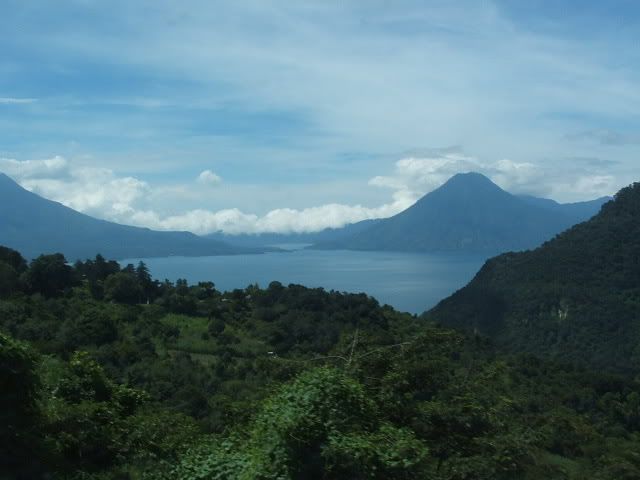
Pretty spectacular, yeah? Wait till you see the other shots.
We set out very early on a Friday morning from Xela, and we shared a shuttle with, among others, four Americans who happened to be going to the same hotel. They´re pretty amazing odds, considering the number of towns, not to mention accomodations, around the lake. More about them later.
Panajachel is the first stop for most travellers to the Lake, as it is the port where all the boats (or lanchas) to other towns and some hotels are docked. Apparently called "Gringotenango" by some guatamaltecos, Pana is even more touristy than Antigua, but with very little of Antigua´s charm or history. It was a popular hippie centre in the 60´s, and now most of the hippies have become astute businessmen and control a lot of the tourist trade. It´s also very hard to stay in one place without local street vendors of all ages accosting you and trying to sell you all manner of merchandise, some of it utter crud. One such urchin was particularly persistent, and after selling Eva a broken item (after which she chased him down the street in order to get an unbroken one), he came back to the place where were having lunch and asked us to buy him a coke. After we pointed out to him that he already had more than enough money from his previous sale, he told us very smartly to "come caca" ("eat shit").
After lunch, and after a fair amount of arguing with an entreprenurial spuiker about the boat fare, we headed out across the lake for our hotel, as it can only be reached by boat (as with a lot of the actual towns on the lake).
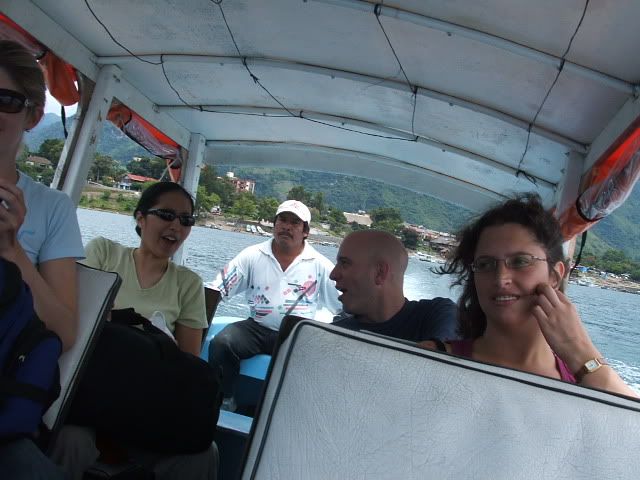
As you can probably tell, it wasn´t a smooth ride. Shayne found the whole experience terrifying, in a rather fun way:
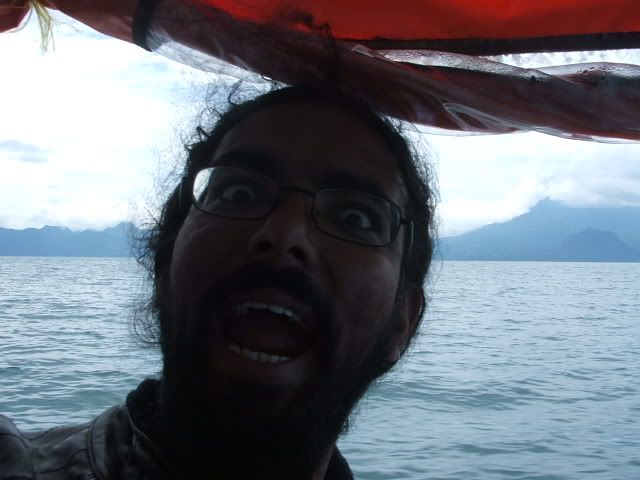
Anyway, it took about 20 minutes to get there. The hotel, La Casa Del Mundo (http://www.lacasadelmundo.com), consists of a group of beautiful stone or stucco-covered buildings perched on a cliff just abover the water, rather like this one, which we initially thought was the hotel but was actually on the opposite side of the same inlet the hotel was on:
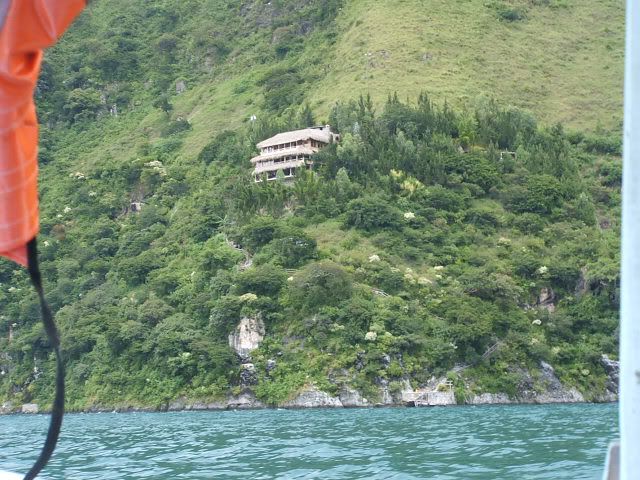
Yes, Shayne sucks because he didn´t get a picture. Look at the website. At this point, we´d really like to thank Eva´s sister, Kat, for recommending this hotel to us. It is probably the nicest hotel we´ve ever stayed in, and it wasn´t just the setting that made it so, although it certainly helped. All the rooms and decks have amazing views. This is the vista from the patio outside our room, where you can see Volcán San Pedro looming behind our new friends´heads:
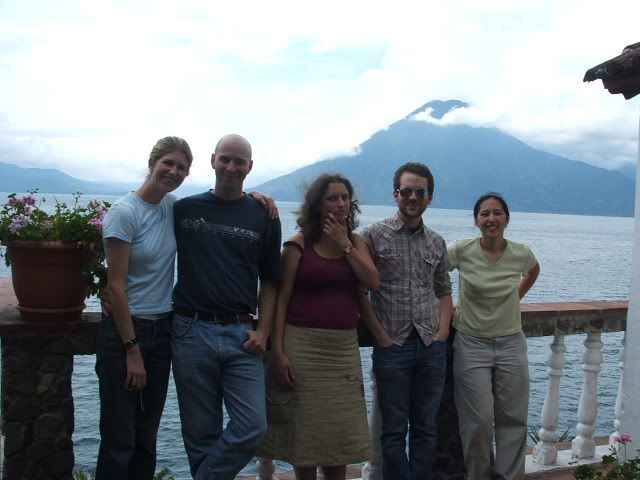
L-R: Katie, Peter, some weird girl stalking us, John, and Christine. We spent a lot of time with these poor saps over the next couple of days. The lucky buggers were in a room with a balcony:
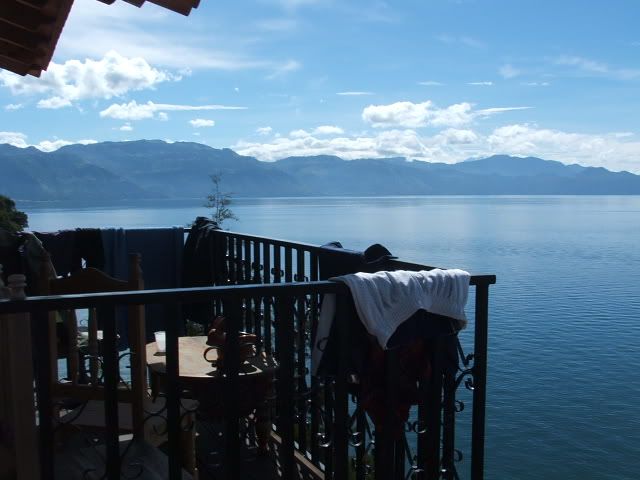
As we said earlier, the weather in Guatemala generally follows the "four seasons in one day" pattern, and this was particularly obvious when comparing the views of the lake at different times of the day.
Volcán San Pedro by morning:
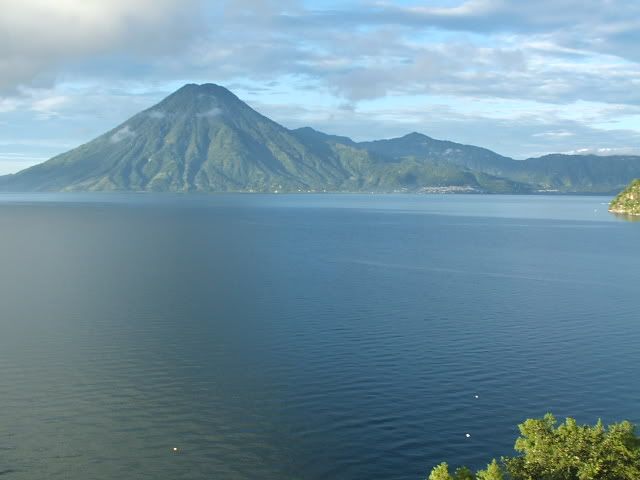
...in the afternoon when it´s raining:
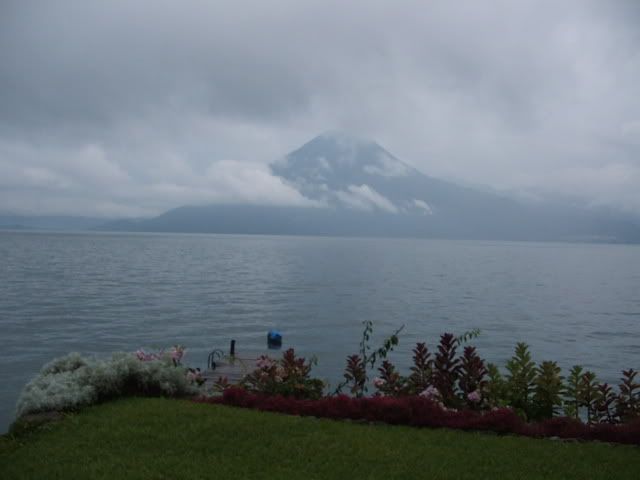
...and during a stormy sunset (sometimes it pays to have a camera that can´t focus properly in the dark):
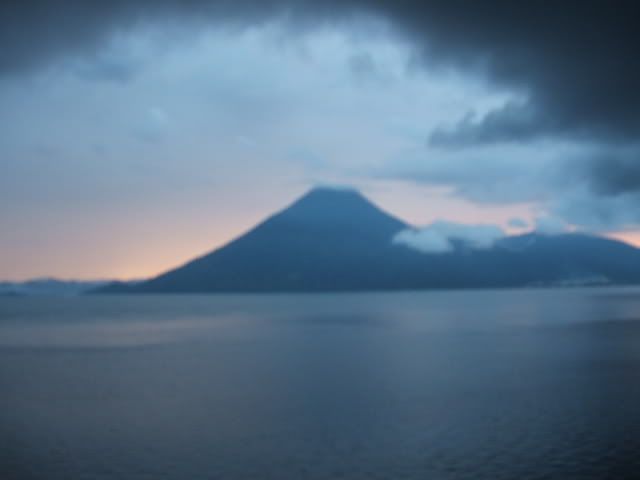
The next two days were filled with a whole lot of nothing. Lots of eating very very good food (especially at night, which was a delicious four-course family-style meal with all the guests for 70-75 quetzales, which is about 12 Aussie bucks), a fair amount of drinking, some kayaking (which Shayne actually did find terrifying when the wind started to pick up and the water became very choppy), and relaxing in a wood-fired hot tub late at night, which overlooked the lake. It rained both nights, and being out there in the very hot water with cold rain dropping on your head was quite invigorating. We also visited San Pedro to get grog to have in the hot tub, but it wasn´t worth taking pictures of.
On the Sunday we returned to Xela with an hour wait in a very wet Pana:
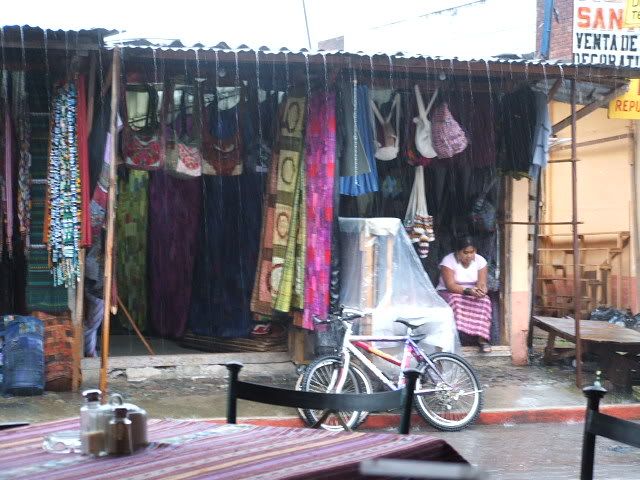
and guess who we saw at exactly the same place we´d stopped to have lunch before? Yep, our little mate. Again, we refused to buy him a coke. Yes, we're mean gringos.
So. Lago de Atitlán is a magical place, and we´d return in a heartbeat, but preferably not in the rainy season. Although the rain made for a spectacular view, it really limited our afternoon activities. Drinking in the sun would have been more fun...
The following weekend after our trip to the lake, and our last in Xela, we went with our Belgian friends from Minerva Escuela, Joke and Aaron, to some Olmec-influenced Mayan ruins on the west of the Pacific Coast called:
Tak´Alik´Ab´Aj (pronounced "tuck aleek ab ach", with pauses between each word. Get it right, people!)
The Olmecs were a race of pre-Classic people originally from Mexico, and it is thought that they travelled to this site, among others, and settled and interbred with the local Mayan population, influencing much of the culture.
These ruins are nowhere near the scale of some of the more famous ones in Guatemala such as Tikal, Uaxactún, or Copán just over the boreder in Honduras, but they are the oldest, with some of the ruins being dated at 300 BCE. The ruins of a once huge settlement of nine terraces are now mostly buried under volcanic soil used for coffee and rubber plantations. The comparatively small area that makes up the national park and which contains some of the central and most sacred ruins (most of which are still being excavated) was dontaed to the Guatemalan government by one of the farmers. We weren´t allowed to take photos of recently-excavated sites, understandably, but true to form, we got plenty of others. Here is a small subset...
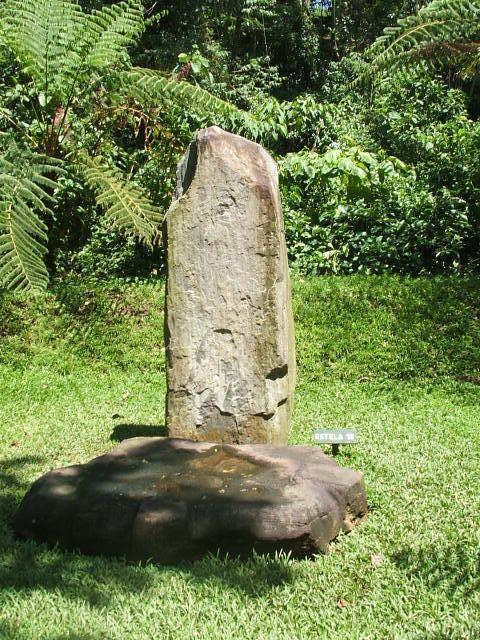
This stelae (a sacred monolith placed at an altar) may not seem so impressive, but the fact that it´s a massive chunk of granite, and that there´s no supply of granite anywhere near the vicinity (the closest source is actually on the other side of the country) makes its appearance here seem quite an achievement. And puzzling. Why the hell (not to mention how) did they lug this damn thing so far?
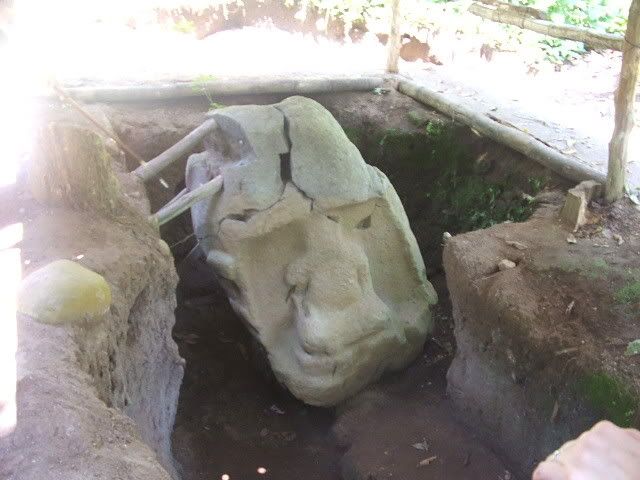
This is an example of a carving that was changed over time. It started off as an Olmec-style head (you can still see the ear and what was the bridge of a nose) and later someone came along and tried to carve a cross-legged Buddha-esqe (it looks like it to us, anyway) figure instead.
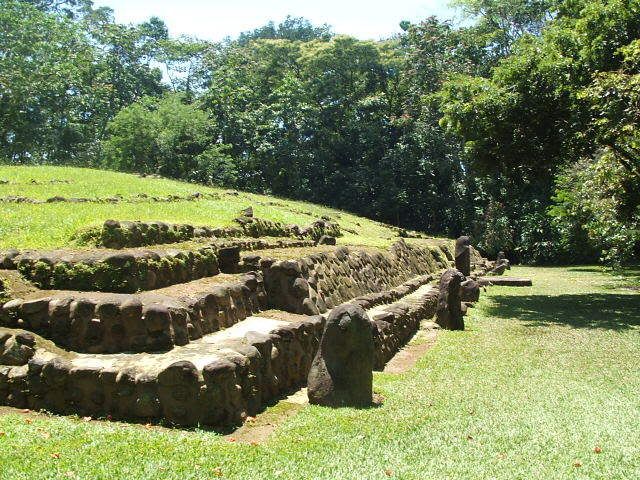
In the centre of the settlement (just on the edge of what was the main plaza) are the remains of this temple. This is the west side, which for the Mayans represented the direction in which the sun went into the underworld every night. The west is associated with death and darkness. The number "7" was (and still is) linked to the underworld, whereas "9" is linked to the east, light and the living world. For this reason, there are nine figurines on the east side and seven on the west side. One of the west-facing figureines was this croc:
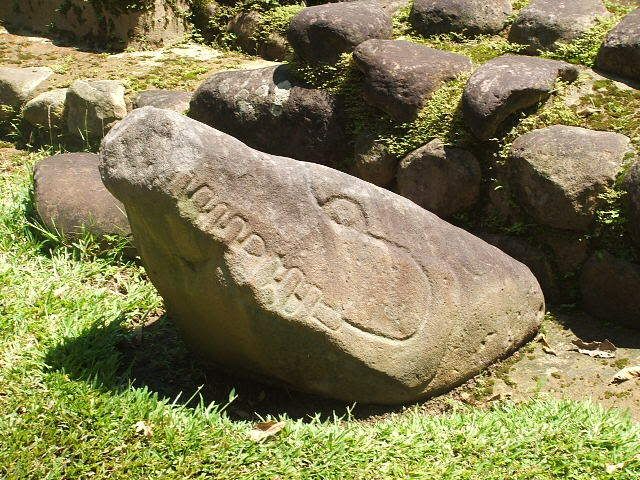
which was done neither in Olmec nor in general Mayan style (think warriors and supernatural creatures from the underworld), but in local style, depicting regional animals. The croc is supposed to be rising out from the underworld. Confused yet? We were - the guide spoke in Spanish and our driver translated for us well enough, but there was a lot of information to take in in a couple of hours.
Finally, this is the wall of another temple (they think) that has only been partially excavated - the rest of it's still under this hill!
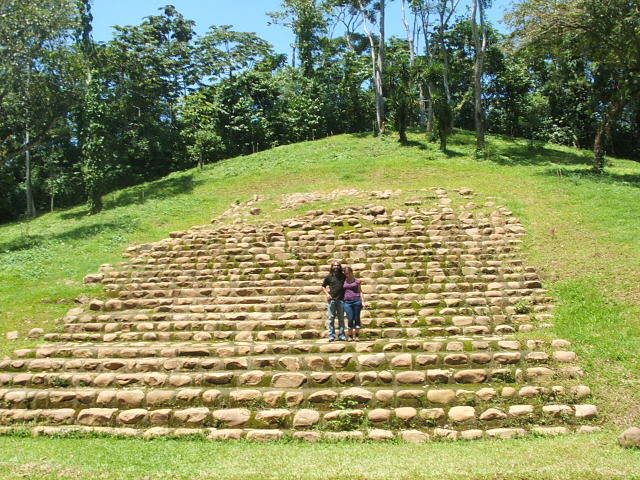
So, now we take you back to the Antigua area, where we returned to for our last week and a half in Guatemala. And finally, Eva managed to drag Shayne's reluctant backside up:
Volcán de Pacaya
At the ungodly hour of 6 am, we were taken to the national park where the volcano is situated. Along with us were a group of five young Israelis whose company became increasingly tedious as the trip went on. There were a few reasons for this. Firstly, they weren't the most sociable bunch - but worse, a couple of them were extremely rude to our amicable guide, Arturo. We'll leave the criticism at that.
As we had been told would happen, as soon as we got to the foot of the volcano, the van was mobbed by a group of young local boys brandishing sticks for hiking, available for rent for 5 quetzales. Eva bought one. Shayne got two, because he is old. Eva also got a picture with one of these entreprenurial lads:
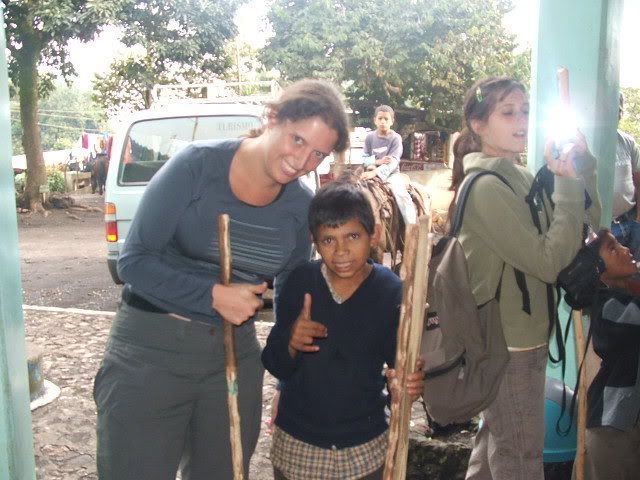
Eva also bought a bag of 40 bloody marshmallows. Why marshmallows? You'll see...
The climb was quite long and very steep, but had amazing views at some points, both of the cone of Pacaya which was belching smoke, and the three more distant volcanos near Antigua:
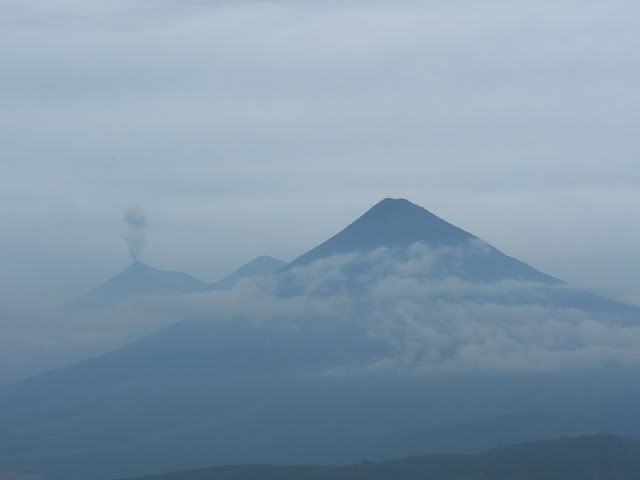
L-R: Fuego (active and puffing away merrily), Acetenango, and Agua, which are both dormant. For now...
Not only was the hike quite gruelling, but you had to watch where you stepped, as horses are taken up the volcano with tour groups frequently and leave presents everywhere. In fact, Eva got about 2/3 of the way up before she decicided to swallow her pride and avail herself of one:
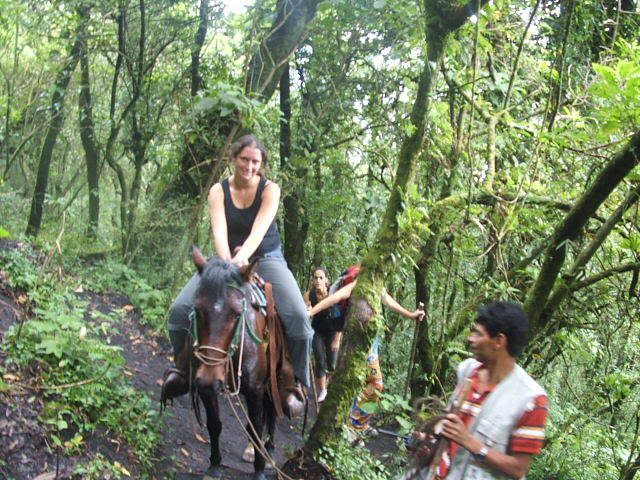
She would like to point out that one of the other girls walked about three paces up the slope before getting on a horse. And she had supposedly been in Israeli military service for two years!
When we finally got to the top of the ridge, where the greenery ends and the harsh lansdcape of the volcanic crater comes into view. This crater is filled with lava, a lot of it still molten, and is actually formed by the lava being belched from the summit and pooling at the base of the cone. It's an amazing sight.
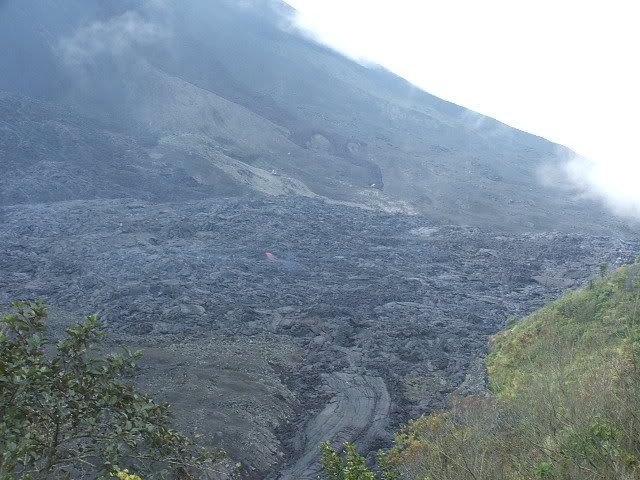
And, rising though the mist and the smoke of its own making, is Pacaya's cone:
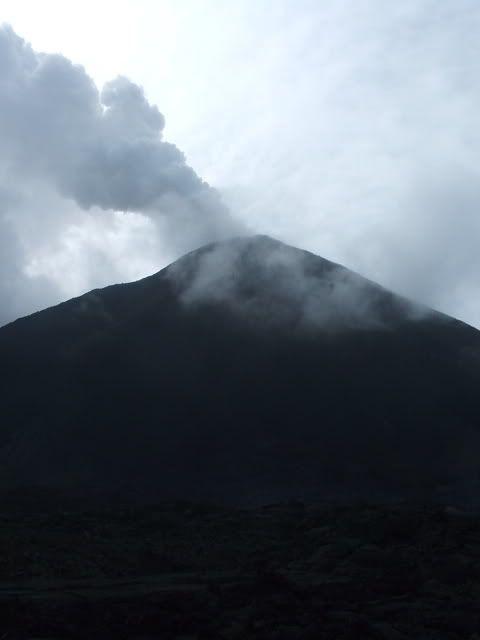
At this point, Shayne was no longer terrified. Just tired and awed. By the time we climbed down onto the crater to walk on the still-hot solidified lava, Eva was amazed and somewhat concerned by Shayne's bold and foolhardy behaviour, as the pyromaniac in him emerged and he cried out repeatedly: "I want to poke the lava with my stick!" (hmm...multiple entendres...) Which is actually more or less what we all did - remember the marshmallows?
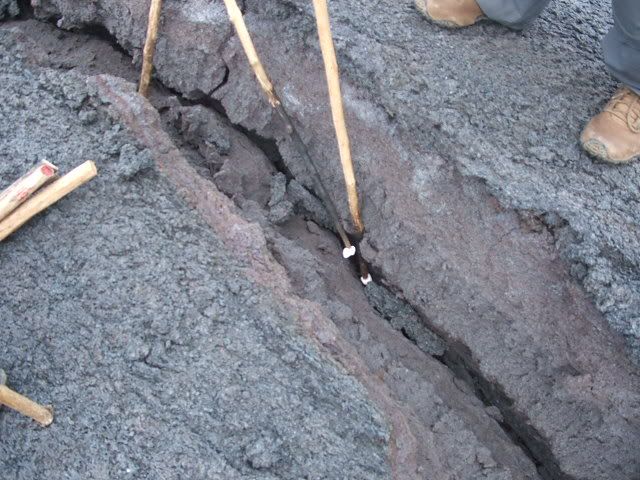
Mmmmm.
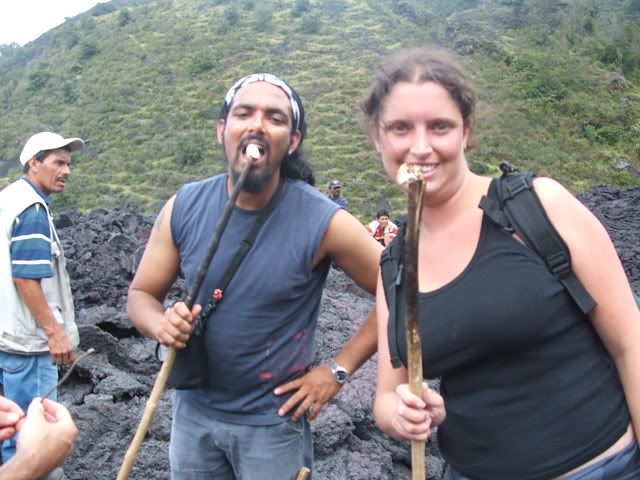
Nearby (we're talking no more than two metres) was a flow of molten lava, slowly making its way towards us.
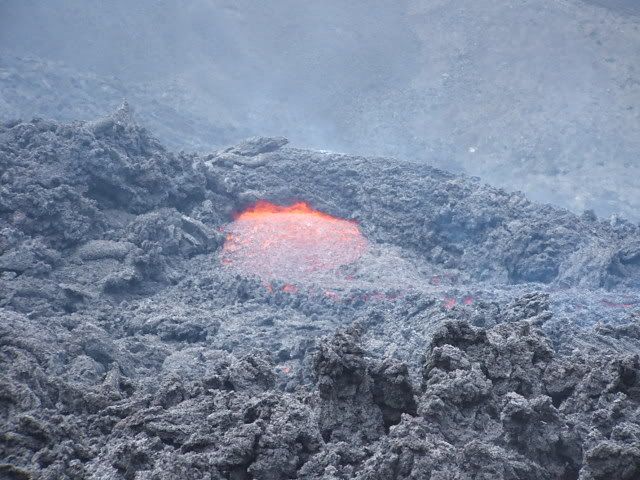
Actually, there were a few:
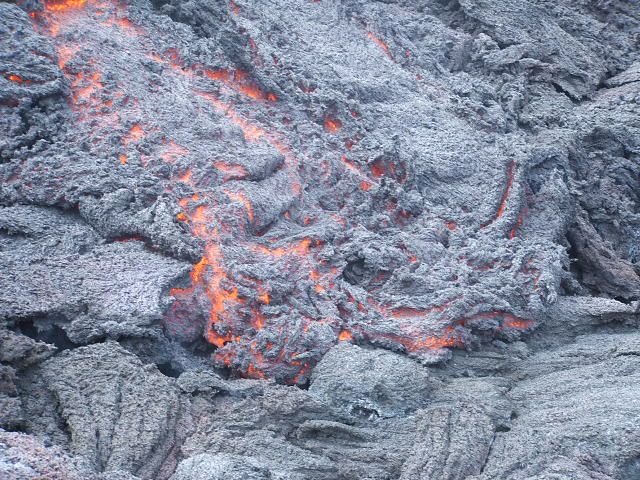
Suffice to say, it was as hot as you'd imagine hell to be. If there were anything like this in Australia, we guarantee you that you'd not be able to get as close to lava as this, and at the very least there'd be more safety restrictions in place. Here, the enthusiastic Arturo jumped from one island of solidified lava to the next, whooping and showing us how to expertly toast marhmallows, emphasising the importance of turning the stick ("Vuelta! Vuelta!").
After about twenty minutes of sizzling on the lava field, most of the group retired to a slightly cooler part of it to have a snack and a rest. Shayne, however, could not resist tempting the volcano with his new-found bravado, and accompanied by the other bloke in our entourage, went back into the heat, out of sight of the rest of the group. Shayne must say, you could almost pretend you were in the middle of a post-apocalyptic wasteland after just a few steps. All you could see was smoke and lava, and the heat was unbelievable. After a bit more roaming, even Arturo was getting worried about them, and called them back. Just before we left the field, the other guy turned around, planted his stick in the rock, and said, "Respect" to the smoking cone. Shayne had to agree.
So, now we'd finally climbed an active volcano. It was time to relax once again, this time at:
Earth Lodge
It's a little retreat on an avocado farm in the mountains about 20 minutes from Antigua. It's very rudimentary - only one shower that had hot water, which you had to pay for; very simple and rustic elevated cabins among the trees; a treehouse which is always booked out, funnily enough; and, of course, long-drop dunnies. This was our favourite of the four:
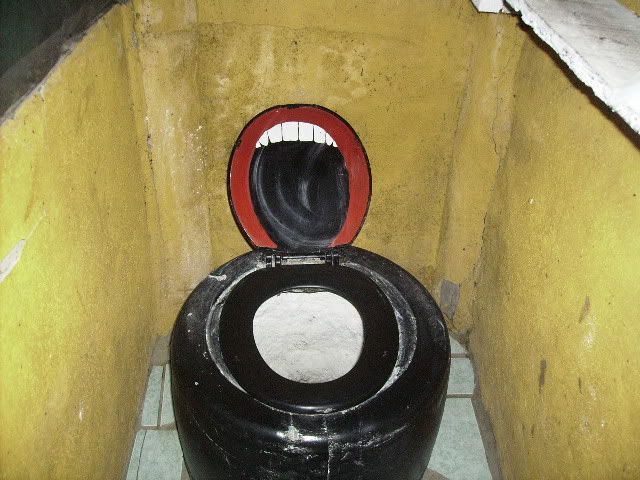
The simplicity of the place was part of the charm. There actually isn't a lot to do, but that makes it perfect for just lying in a hammock and reading:
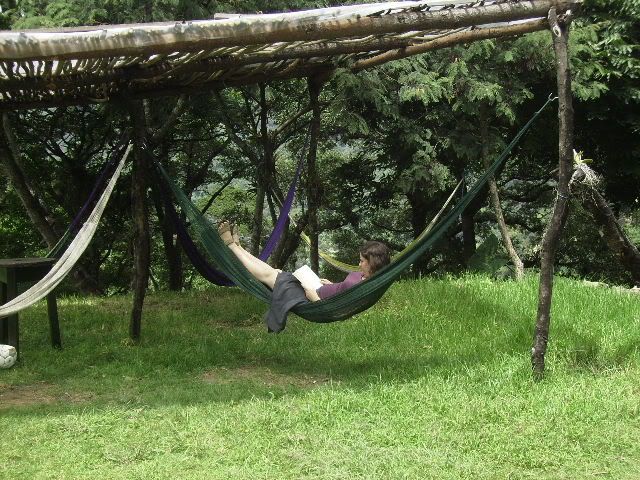
...watching DVDs in a cozy little movie room, or even playing a weird game involving throwing horseshoes at two stakes. Apparently it's a big Canadian pastime, and it fits, because the place is run by a Canadian, Drew, and his American wife, Brianna. Another thing you can do here is get a tattoo. We didn't get one - there was no time to, especially since the resident tattoo artist, John from Columbia, was doing this large piece on Drew's leg the entire Friday we were there:
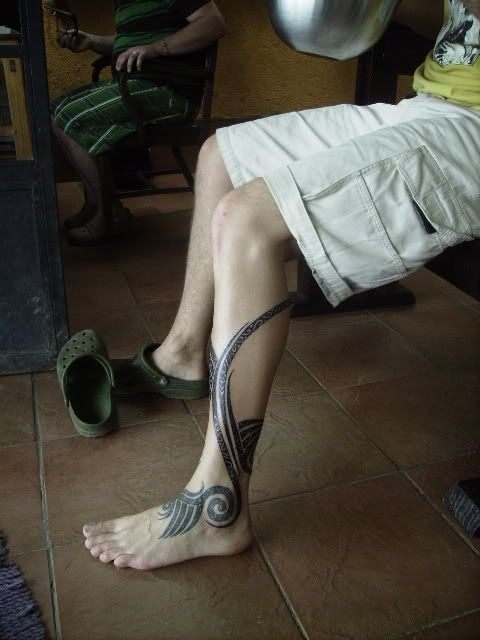
He also makes jewellery out of coconut shells and semi-precious stones, which are very cool:
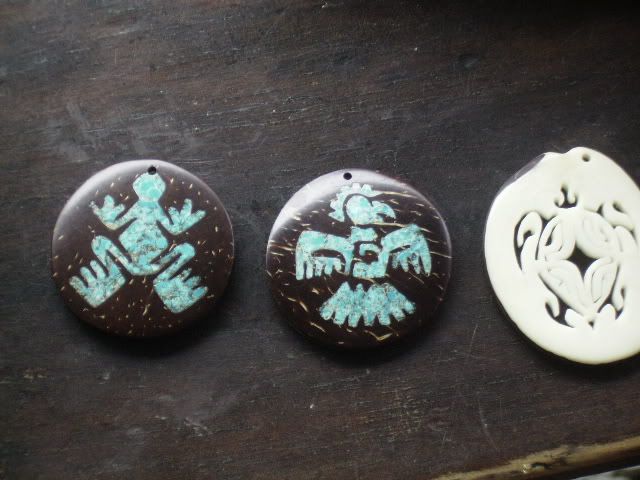
Shayne bought one, but the stupid moron lost it in Antigua last night. Eva still has hers. That will teach Shayne never to drink again...yeah...
Anyway, apart from all that, you could just sit on the hillside and look at the spectacular view:
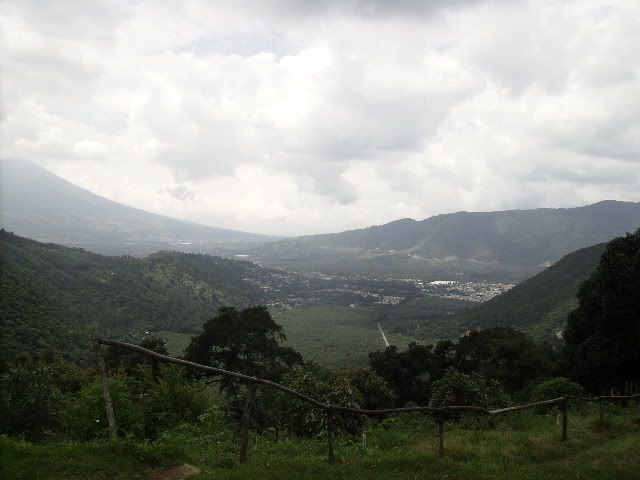
While doing this, we were often joined by the resident canines, Whitey and Lola:
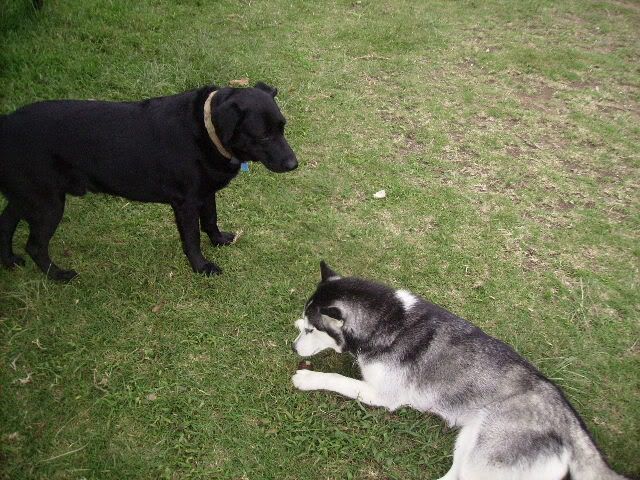
After seeing so many street dogs and even pets that obviously aren't very well taken care of, it was really nice to see two such healthy, happy dogs. Eva immediately started with the whole "I wanna puppyyyyy!" routine.
After staying there for two days, we headed back to Antigua, only to return a day later for their annual Canadian Thanksgiving dinner, with a whole lot of other people who'd come up especially for the occasion. Everyone was really nice, and in very good spirits (particularly after happy hour and the strawberry daquiris):
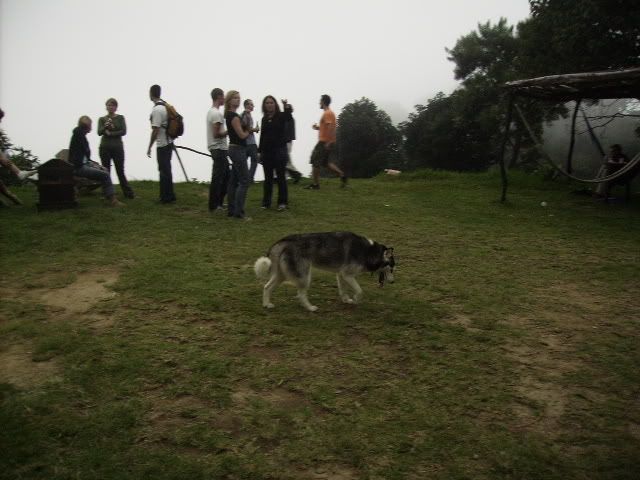
We really hope to return one day. Not just here - back to Guatemala. Apart from revisiting the places we've loved, we still want to see the famous Tikal ruins, and visit the Carribean Garifuna settlement of Livingston on the east coast, and Shayne would one day love to be fit enough to do the 5-day-hellish-trek-through-the-wild-jungle in the north to visit El Mirador, another Mayan site which boasts the largest Mayan pyramid ever found. Eva would also love to see it, but she's not sure about the killer mosquitos, considering she's already had a leg infection from a reaction to bites during this trip.
This brings us to the end of our stay in Guatemala. Today is our last day, and tomorrow we fly to New York. It's going to be a real sensory overload after the laid-back pace of Guatemala. To say goodbye to Antigua and Guatemala in general, we went with the tourist police this afternoon to Cerro de la Cruz (Hill of the Cross), which overlooks Antigua:
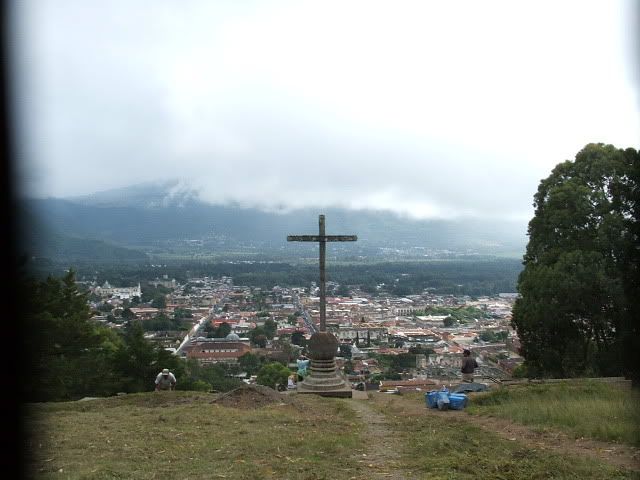
It seemed a fitting way to say Adios.
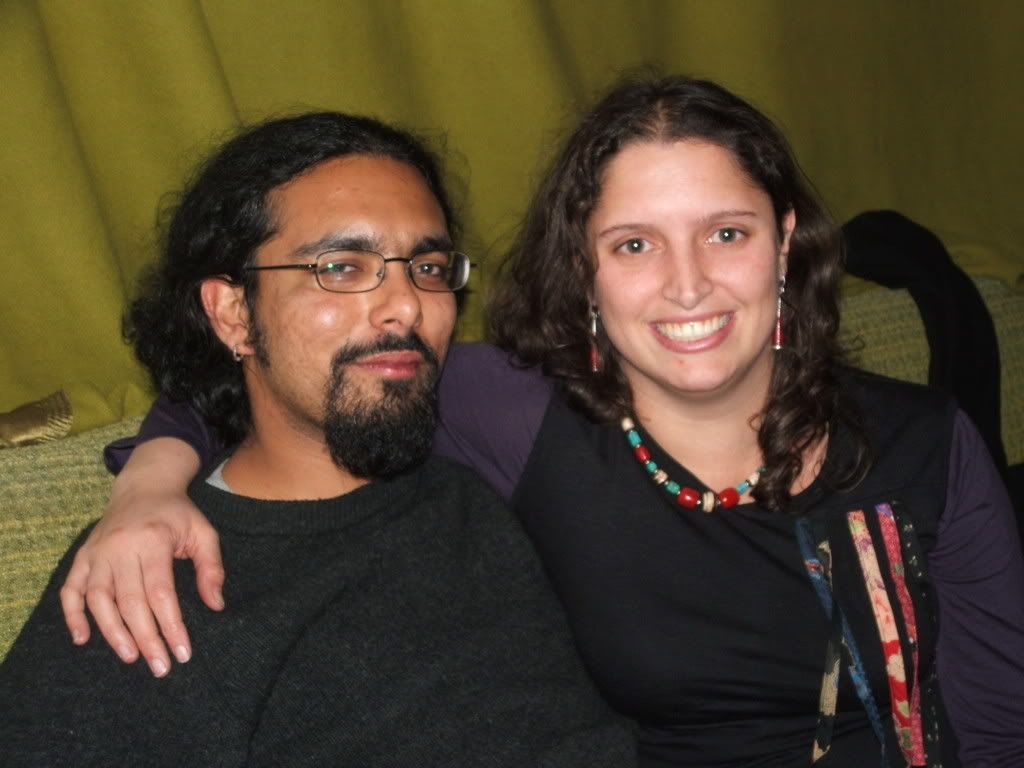
No comments:
Post a Comment